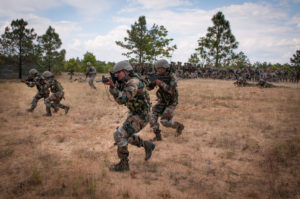Uri Terror Attack: The Kashmir Dilemma Revisited
 Four heavily armed terrorists reportedly snuck into the 12th Infantry Brigade lodging of Uri, a small Indian town, and killed eighteen Indian Army personnel on September 18. This was the largest number of soldiers killed in conflict between the two countries since the signing of a comprehensive ceasefire in 2003. The incident was also the worst attack on Indian territory since Pakistan and India signed the Simla Agreement in 1972, which ended the Indo-Pakistani War and established the Line of Control and de facto border between both nations.
Four heavily armed terrorists reportedly snuck into the 12th Infantry Brigade lodging of Uri, a small Indian town, and killed eighteen Indian Army personnel on September 18. This was the largest number of soldiers killed in conflict between the two countries since the signing of a comprehensive ceasefire in 2003. The incident was also the worst attack on Indian territory since Pakistan and India signed the Simla Agreement in 1972, which ended the Indo-Pakistani War and established the Line of Control and de facto border between both nations.
The ceasefire encompasses the international border, the Siachen Glacier in Jammu and Kashmir, and the Line of Control (LoC)—an area only a few kilometers from Uri. The recent attack signifies an escalation of tensions between India and Pakistan, particularly as India contends that the Pakistani government sanctions these terrorist attacks and views them as a “pillar of its foreign policy.”
As with many clashes between India and Pakistan, this attack’s cause lies in the historical separation of the two states, which was mired in violence and terror since 1947 and which spurred multiple military clashes between the two states following their independence.
The issue of Kashmir, another byproduct of partition, provides the central territorial dispute that fuels tensions between both governments today. Kashmir’s militarization by the Indian army has led to protests and calls for autonomy from the domestic Kashmiri population, but the divided land also serves as a hotbed of terrorism. A terrorist hub on key strategic land between India and Pakistan cannot be left unaddressed. However, the caveat that any military involvement is met with domestic unrest and further violence leaves Indian decision makers with quite the conundrum.
In such a dynamic environment, especially with the added consideration that both India and Pakistan now possess nuclear capabilities, it is important to view current conflicts through a broader regional lens. India has continued to speak out against Pakistan’s alleged state sponsoring of terrorism, with Indian Prime Minister Modi assuring that the “nation behind this despicable attack will not go unpunished.” After this declaration was made at a meeting of Modi’s leading Barti Janta Party, surgical operations into Pakistani territory were approved. On September 28th, India carried out specialized attacks on seven terrorist launch pads, essentially bunkers where terrorists take shelter before crossing the border into India, as a retaliatory strike on behalf of the Uri attack.
Indian forces have conducted past successful cross border raids across the LoC, particularly as a form of revenge for inhumane beheadings of its soldiers.However, the key difference is that the scale of these past excursions have been small and the matter regulated to internal military affairs. Never before has the Indian government formally come out to take responsibility for a cross border strike, suggesting that India is no longer willing to take a reconciliatory approach to further acts of terror and expects Pakistan to adhere to international norms.
Meanwhile, Pakistan denies the existence of a surgical strike, stating that India is misconstruing cross border fire in order to distract is domestic populace from events occurring in Kashmir. Additionally, India’s refusal to attend the upcoming SAARC summit in Islamabad comes on the heels of this conflict, with Afghanistan, Bangladesh and Bhutan also conveying intentions of not attending. The current atmosphere will likely not see a decrease in tensions, especially considering both states’ current rhetoric.
